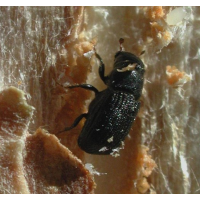Bark Beetles Thrive in Drought, Rampage Through California Forests
 Mountain pine beetle (photo: U.S. Forest Service)
Mountain pine beetle (photo: U.S. Forest Service)
Tiny bark beetles are celebrating the four-year drought by killing billions of trees nationwide and rampaging through California conifer forests.
Forestry officials estimate that 20-40% of the trees between Calaveras County and the Kings County area near Fresno are dead or dying, according to the San Francisco Chronicle. Nearly 85% of the Monterey pines in Cambria on the coast are in the same shape.
“In the southern Sierra Nevada it’s devastating,” Tom Smith, a forest pest management specialist for the California Department of Forestry and Fire Protection (CalFire), told the Chronicle. “It’s epidemic and it’s probably going to get even worse.”
Numerous species of bark beetles are diversified among various regions of the state, with each one having their own favorite conifers. Pines get a big shout-out, but fir and spruce have their fans.
When the trees are healthy, they produce enough resinous pitch to resist the beetles, which want to bore in, settle down and raise a family. Once the beetles do that, their larvae tap into the trees’ tissue for nourishment and disrupt their flow of nutrients. But the drought does more than stress the trees and leave them vulnerable.
The dry, hot weather facilitates beetle breeding, and they have had a record amount of both this winter. As the beetles deliver a final death blow to the already-weak trees, many believe the massive die-off increases the likelihood of devastating fires.
Not surprisingly, this threat is viewed as an opportunity by some. Foresters are thinning out strands of trees, but the logging industry and its supporters want to be far more aggressive. Mother Jones reported that Congress has considered 50 bills since 2001 to increase logging as a result of bark beetles.
But a new study from the Proceedings of the National Academy of Sciences says Congress and loggers should back off. The study results “refute the assumption that increased bark beetle activity has increased area burned,” according to its abstract summary.
“The assumption that outbreaks raise fire risk is driving far-reaching policy decisions involving expenditures of hundreds of millions of dollars. Contrary to the expectation that an MPB outbreak increases fire risk, spatial overlay analysis shows no effect of outbreaks on subsequent area burned during years of extreme burning across the West.”
There is much talk on all sides of the issue about the cyclical nature of bark beetle infestations, with parallels drawn to the great tree die-out of 2003 that prompted Governor Gray Davis to call a state of emergency in Los Angeles, Riverside, San Bernardino and San Diego counties.
But old patterns and assumptions may not be relevant anymore. Sarah J. Hart, a co-author of the beetle/fire study, told High Country News, “For any manager concerned about whether their forests are going to burn or not, I think they should focus more on trying to adapt to changes in climate rather than changes to fuels from mountain pine beetle infestation.”
–Ken Broder
To Learn More:
Bark Beetles Ravaging Drought-Stricken Forests in California (by Peter Fimrite, San Francisco Chronicle)
Sierra Nevada Pine Tree Die-Off Worsens as Beetles Thrive in Drought (by Lewis Griswold, Fresno Bee)
Bark Beetles Are Decimating Our Forests. That Might Actually Be a Good Thing. (by Maddie Oatman, Mother Jones)
Don't Blame Bark Beetles for Fire Risk (by Sarah Jane Keller, High Country News)
Bark Beetles and Climate Change in the United States (U.S. Forest Service)
Bark Beetles in California Conifers: Are Your Trees Susceptible? (U.S. Department of Agriculture) (pdf)
Area Burned in the Western United States Is Unaffected by Recent Mountain Pine Beetle Outbreaks (by Sarah J. Hart, Tania Schoennagel, Thomas T. Veblen and Teresa B. Chapman, Proceedings of the National Academy of Sciences)
- Top Stories
- Controversies
- Where is the Money Going?
- California and the Nation
- Appointments and Resignations
- Unusual News
- Latest News
- California Forbids U.S. Immigration Agents from Pretending to be Police
- California Lawmakers Urged to Strip “Self-Dealing” Tax Board of Its Duties
- Big Oil’s Grip on California
- Santa Cruz Police See Homeland Security Betrayal in Use of Gang Roundup as Cover for Immigration Raid
- Oil Companies Face Deadline to Stop Polluting California Groundwater





